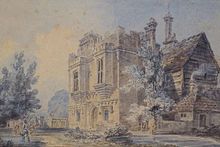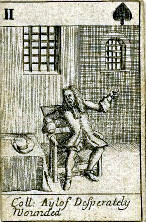Richard Rumbold
Richard Rumbold | |
|---|---|
 Rye House, Hertfordshire,Rumbold's residence from 1660 to 1683; 1793 watercolour byJ. M. W. Turner | |
| Born | 1622 Royston, Hertfordshire(possibly) |
| Died | 26 June 1685 (aged 62–63) Edinburgh |
| Allegiance | |
| Years of service | 1642–1659 |
| Rank | Captain |
| Unit | Cromwell's Regiment |
| Battles/wars | Wars of the Three Kingdoms DunbarWorcester Argyll's Rising |
Richard Rumbold(1622–1685) was aParliamentariansoldier and political radical, exiled for his role in the 1683Rye House Plotand later executed for taking part in the 1685Argyll's Rising.
During theWars of the Three Kingdoms,he joined theNew Model Army,and was one of the guards at the execution ofCharles I of Englandin January 1649. He reached the rank ofCaptainbefore being dismissed from the army after the1660 Restoration.
Closely involved with radical politics, he was implicated in the 1683Rye House Plot,an alleged plan to assassinateCharles II of Englandand his brotherJames.After it was discovered, he escaped to theDutch Republic,then took part in the 1685Argyll's Rising,an unsuccessful attempt to drive James from the throne. Captured after being badly wounded, he was executed atEdinburghon 26 June 1685.
His speech from the scaffold included the statement "none comes into the world with a saddle on his back, neither any booted and spurred to ride him." These words were quoted during theUS Constitutional Conventionin 1787, and byThomas Jeffersonshortly before his death in 1826.
Biography
[edit]Little is known of Rumbold's background, except that he was born in 1622, and his family came fromHertfordshire,possiblyRoyston.He had a brother, William, who took part inMonmouth's Rebellionbut was pardoned in 1688.[1]
Dismissed from the army followingThe Restorationin 1660, he married a widow who owned aMaltingbusiness based atRye House, HertfordshirenearHoddesdon.There is no record of any children from this marriage.[1]
Career
[edit]
He joined theParliamentarianarmy in 1642 and served throughout theWars of the Three Kingdoms,joining theNew Model Armywhen it was set up in 1645. At some point, Rumbold lost an eye, though it is unclear if this was a battle injury, and as a result was known to his friends asHannibal.Rumbold was aBaptist,a sect particularly prominent in the New Model, and closely associated with the radicalLevellermovement. He claimed to have been present at the execution ofCharles I,and in February 1649 was one of those who petitioned forAgitatorsto be re-appointed to theArmy Council.[2]
Oliver Cromwellviewed the Agitators with great hostility, especially after their role in organising the so-called Leveller mutinies in April and May.[3]Rumbold seems to have withdrawn from the group, as his name does not appear on the version of the petition printed by the Levellers, and was rewarded with a commission. During theThird English Civil War,he fought at the battles ofDunbarandWorcester;when it ended in 1651, he was aLieutenantin Cromwell's Regiment of Horse. He was dismissed from the army with the rank of captain at the1660 Restoration.[4]

Rumbold remained politically active after the Restoration, and was prominent within radical circles, many of whom were also Baptists and New Model veterans. They included former Agitators Abraham Holmes and John Harris, who were also present at Charles' execution, Rumbold's cousin John Gladman, and his brother William.[4]This group was closely involved in the 1679 to 1681 campaign toexcludethe CatholicJamesfrom succeeding his brotherCharles II.They helped organise the 1680 'Great Petition' demanding the recall ofParliament,signed by 18,000 people, includingJohn Ayloffe,Richard NelthorpeandRobert Ferguson.[5]
All of the above were implicated in theRye House Plot.Named after Rumbold's home, the plan was to ambush Charles and his brother as they returned toLondonfromNewmarketin March 1683. Rumbold was reportedly given the task of killing Charles, although there is considerable debate as to how serious it was, or what its objectives were. In his speech from the scaffold in 1685, Rumbold denied any intention of murdering the king, but after warrants for his arrest were issued in June, he escaped to theDutch Republic.[6]
Here he joined other exiled opponents of theStuarts.The most prominent wereArchibald Campbell, 9th Earl of Argyll,convicted of treason in 1681, and Charles' illegitimate son,James Scott, Duke of Monmouth,exiled for his involvement in the Rye House Plot. Preparations for a rising became more urgent with the accession of James after the death of Charles in February 1685, and the two agreed to work together. To ensure co-ordination, a leading Scots exile,Andrew Fletcher of Saltounaccompanied Monmouth, while Rumbold and Ayloffe went with Argyll.[1]

Unfortunately,Argyll's Risingfailed to attract significant support, and was fatally compromised by divisions among the rebel leadership, Rumbold being one of the few to emerge with any credit. After Argyll was captured on 18 June, the others were ordered to disperse; intercepted by militia on the night of 20/21 June nearLesmahagow,Rumbold killed one assailant, wounded another two, and was captured only when his horse was shot from under him. Brought to Edinburgh seriously wounded, he was tried, convicted of treason on 26th and executed the same day, allegedly to ensure he did not die of his wounds first.[7]
Ayloffe was executed later that year in London along with Nelthorpe, who served with Monmouth, as did William Rumbold, pardoned in 1688 for his participation.[1]Rumbold made his own defiant declaration on the scaffold:
This is a deluded generation, veiled in ignorance, that though popery and slavery be riding in upon them, do not perceive it; though I am sure that there was no man born marked by God above another; for none comes into this world with a saddle on his back, neither any booted and spurred to ride him...[8]
This echoed words published thirty-seven years earlier by Harris inMecurius Militaris;'Children of kings are born with crowns upon their heads, and the people with saddles upon their backs.'[9]Rumbold's own words would themselves be quoted in 1787 during discussions on the definition of treason at theConventionthat drew up theConstitution of the United States.[10]
Ten days before his death,Thomas Jeffersonalso borrowed from Rumbold's speech in his letter of 24 June 1826 to theMayor of Washington, D.C.He wrote, "...All eyes are opened or opening to the rights of man. The general spread of the light of science has already laid open to every view the palpable truth, that the mass of mankind has not been born with saddles on their backs, nor a favored few, booted and spurred, ready to ride them legitimately by the grace of God."[11]
References
[edit]- ^abcdClifton 2004.
- ^De Krey 2018,p. 323.
- ^BCW Project.
- ^abSouthern 2001,p. 149.
- ^Knights 1993,pp. 53–54.
- ^Marshall 2005.
- ^Fountainhall 1840,p. 183.
- ^Howell 1816,p. 882.
- ^Rees 2016,p. 258.
- ^Adair 1952,p. 523.
- ^McCullough 2001,pp. 644–645.
Sources
[edit]- Adair, Douglass (1952). "Rumbold's Dying Speech, 1685, and Jefferson's Last Words on Democracy, 1826".The William and Mary Quarterly.9(4): 521–531.doi:10.2307/1923756.JSTOR1923756.
- BCW Project."The Leveller Mutinies".BCW Project.Retrieved8 August2020.
- Clifton, Robin (2004). "Rumbold, Richard".Oxford Dictionary of National Biography(online ed.). Oxford University Press.doi:10.1093/ref:odnb/24269.(Subscription orUK public library membershiprequired.)
- De Krey, Gary S (2018).Following the Levellers, Volume Two: English Political and Religious Radicals from the Commonwealth to the Glorious Revolution, 1649-1688: Volume 2.Palgrave Macmillan.ISBN978-1349953295.
- Fountainhall, Lauder (1840).Historical Observes of Memorable Occurrents in Church and State, From October 1680 to April 1686(2019 ed.). Wentworth Press.ISBN978-0526064717.
- Howell, Thomas (1816).A Complete Collection of State Trials and Proceedings for High Treason; Volume IX.TC Hansard.
- Knights, Mark (1993). "1680: London's Monster Petition".The Historical Journal.36(1).doi:10.1017/S0018246X00016101.JSTOR2639515.
- Marshall, Alan (2005). "Rye House Plotters".Oxford Dictionary of National Biography(online ed.). Oxford University Press.doi:10.1093/ref:odnb/93794.(Subscription orUK public library membershiprequired.)
- McCullough, David (2001).John Adams.Simon & Schuster.ISBN0684813637.
- Rees, John (2016).The Leveller Revolution.Verso.ISBN978-1784783907.
- Southern, Antonia (2001).Forlorn Hope: Soldier Radicals of the Seventeenth Century.Book Guild Publishing Ltd.ISBN978-1857765199.
